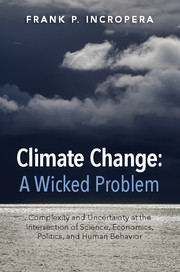 Climate Change: A Wicked Problem
Climate Change: A Wicked Problem Book contents
- Frontmatter
- Dedication
- Contents
- Foreword by Anthony F. Earley Jr.
- Foreword by G.P. “Bud” Peterson
- Foreword by Arun Majumdar
- Preface
- Acknowledgments
- Abbreviations
- 1 Energy, economics, and climate change
- 2 The Earth's climate system
- 3 Greenhouse gases
- 4 Global warming
- 5 Consequences of global warming
- 6 Mitigation, adaptation, and geoengineering
- 7 Public policy options
- 8 The politics of global warming: a history lesson and future prospects
- 9 Dissenting opinions: the great hoax
- 10 The ethics of climate change
- 11 A way forward
- Appendix A Units and conversion factors
- Appendix B Fossil fuels
- Appendix C Anthropogenic sources of natural gas and methane
- Appendix D Environmental time scales and inertia
- Appendix E Coal-fired power plants: operating conditions and costs of carbon capture and sequestration
- Notes
- References
- Index
- Plate section
6 - Mitigation, adaptation, and geoengineering
Published online by Cambridge University Press: 05 October 2015
- Frontmatter
- Dedication
- Contents
- Foreword by Anthony F. Earley Jr.
- Foreword by G.P. “Bud” Peterson
- Foreword by Arun Majumdar
- Preface
- Acknowledgments
- Abbreviations
- 1 Energy, economics, and climate change
- 2 The Earth's climate system
- 3 Greenhouse gases
- 4 Global warming
- 5 Consequences of global warming
- 6 Mitigation, adaptation, and geoengineering
- 7 Public policy options
- 8 The politics of global warming: a history lesson and future prospects
- 9 Dissenting opinions: the great hoax
- 10 The ethics of climate change
- 11 A way forward
- Appendix A Units and conversion factors
- Appendix B Fossil fuels
- Appendix C Anthropogenic sources of natural gas and methane
- Appendix D Environmental time scales and inertia
- Appendix E Coal-fired power plants: operating conditions and costs of carbon capture and sequestration
- Notes
- References
- Index
- Plate section
Summary
If anthropogenic global warming is acknowledged and related threats are taken seriously, what can be done about it? In broad terms, there are three paths that can be taken. The first two are by no means mutually exclusive and, in fact, should be pursued concurrently. One path involves mitigation measures. What can be done to reduce GHG emissions and stabilize atmospheric concentrations at levels of low risk? Globally, can CO2 emissions be reduced to 20% of current levels by 2050 and atmospheric CO2 stabilized at 450 ppm? And what if mitigation measures are insufficient to reduce atmospheric GHG concentrations to acceptable levels, a scenario that is becoming ever more likely?
The second path involves adaptation. Recognizing diminishing prospects for stabilizing GHG concentrations at acceptably low levels, what can be done to increase the resilience of human and natural systems to the effects of climate change? In this chapter we'll examine a range of mitigation and adaptation options. But should mitigation and adaptation measures both fall short of desired outcomes, what then? The chapter concludes with a discussion of measures falling under the rubric of geoengineering – a term used to characterize large-scale engineering endeavors designed to counteract the warming effects of GHG emissions.
We'll begin with mitigation. As shown in Figure 6.1, options for reducing GHG emissions fall into three categories. One category deals with increasing the efficiency of producing and using energy; the second deals with transitioning the world's energy portfolio from carbon-rich to carbon-free sources of energy; and the third deals with collecting and sequestering GHG gases before they are released to the atmosphere. In each case, the scale of implementation needed to achieve meaningful reductions is enormous, requiring large capital investments and global cooperation.
- Type
- Chapter
- Information
- Climate Change: A Wicked ProblemComplexity and Uncertainty at the Intersection of Science, Economics, Politics, and Human Behavior, pp. 108 - 147Publisher: Cambridge University PressPrint publication year: 2015
